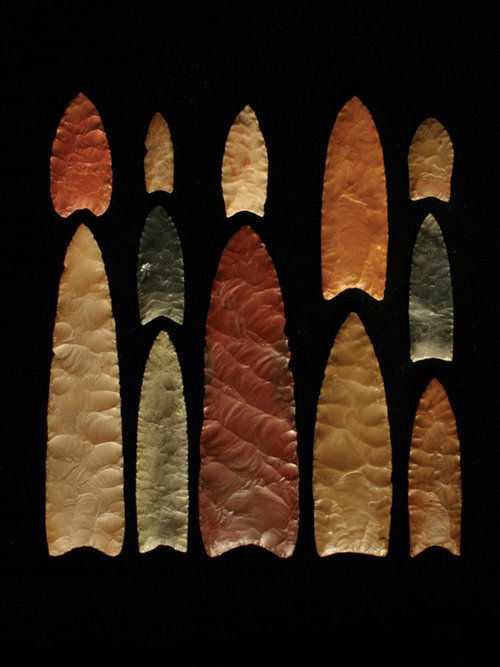
By J.M. Adovasio, Expedition Principal Investigator - Mercyhurst University
and C. Andrew Hemmings, Expedition Principal Investigator - Mercyhurst University

Clovis points from various sites in North America. Image courtesy of Center for the Study of the First Americans, Texas A&M University. Download image (jpg, 57 KB).
Note: This article is an addendum to the 2009 essay Revealing the Origin of North America’s Ancestors, outlining the continued erosion of the 'Clovis-first' scenario.
In the mid-to-late 1960s, it was widely believed that the First Americans not only arrived here on foot from Siberia toward the end of the last Ice Age (ca. 12,000 years ago), but also that these intrepid pioneers were highly mobile, rapidly moving, specialized hunters. Their signature weapon was a lethal lance surmounted by a distinctive stone projectile point called Clovis, named after one of the localities of its recovery in the 1930s in New Mexico. These so-called Clovis hunters were thought to have spread very rapidly across the length and breadth of the New World, arriving at the tip of South America within 500 years of their initial entry. Because of the apparent and not infrequent co-occurrence of Clovis spear points with the bones of extinct animals — notably including mammoth, mastodon, bison and other Ice Age beasts — the makers of these points were believed to be responsible for the extinction of some 35 species of Ice Age animals.
By the early 1970s this chronological and behavioral scenario called “Clovis first” was firmly established as virtual dogma within the North American archaeological community. The prevailing paradigm would begin to be questioned and, ultimately, unravel and collapse only after excavations at widely separated points in North and South America. This research at places like Meadowcroft Rockshelter in southwestern Pennsylvania and Monte Verde in Chile showed that humans had arrived before Clovis and that the lifestyle of these first Americans were very different from what previously had been imagined.
Instead of being specialized, spear-wielding big game hunters, some of the early colonists appeared, instead, to be generalized foragers who collected a wide array of small- to medium-sized animals heavily augmented by a diverse vegetal diet.

Excavations at Monte Verde along Chinchihuapi Creek (in the foreground), where the excavators are uncovering residential structures. Image courtesy of Exploring the Submerged New World 2012 Expedition, Tom Dillehay, NOAA-OER. Download image (jpg, 136 KB).
Direct archaeological evidence of Pre-Clovis populations found across the America’s continues to grow. Recent work in Florida, Texas, California, and on the Middle Atlantic Seaboard, all indicate that not only was the late Pleistocene human population of the New World widespread long before Clovis, but now it appears as though recognizable regional patterns in artifact forms are beginning to emerge. Further, additional evidence of coastal marine resource adapted people has been found on islands off the California coast that is nearly the same age as Clovis.
These data indicate that not only were more people widely scattered in the America’s prior to Clovis that previously thought, but also that people were making a living utilizing resources that have never been found at Clovis sites before Clovis has disappeared.
These two lines of evidence suggest that not only is Clovis not first but that there are Clovis contemporaries that seem to be unrelated to Clovis based on artifact forms and what evidence we have of their diets. To find the earliest entrants into the New World it is necessary to look in the places they would have entered at the time. All of those possible points of initial entry are now underwater. Continued exploration of these heretofore neglected portions of the Pleistocene landscape stand to produce the most significant results in terms of age and novel cultural adaptations (means of making a living that we have not seen before). In order to find the most informative sites we need to consider the landscape as it was, and look for preserved locations that would have been important to the people living on them at the right time.